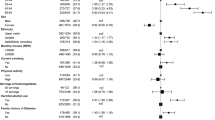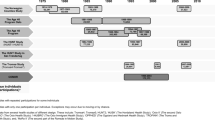Abstract
A 10-year longitudinal population-based study entitled Isfahan Cohort Study (ICS) was conducted in 2001–2011 with cardiovascular disease (CVD) as the primary outcome. We considered ICS as a master plan for a multi-level non-communicable disease (NCD) study named Isfahan Cohort Study 2 (ICS2). ICS2 is a multi-generation 10-year cohort study with new goals and outcomes that have been started in 2013, recruiting a sub-sample of ICS (n = 1487) and a new recruited sample (n = 1355) aged 35 years and over, all living in urban and rural areas of two counties in central Iran. In addition, 2500 of participant’s adult children were selected randomly, as well as 1000 of their grandchildren. The aim of ICS2 is to detect the incidence of some NCDs including CVD, cancers, and diabetes and to identify the impact of their behavioral, metabolic, environmental, and genetic risk factors. In addition, studying lifestyle behaviors in three generations in a hierarchical manner of parents, their children and grandchildren in ICS2 will improve our knowledge on other determinants such as epigenetics of NCDs.
This is a preview of subscription content, access via your institution
Access options
Subscribe to this journal
Receive 12 digital issues and online access to articles
$119.00 per year
only $9.92 per issue
Buy this article
- Purchase on Springer Link
- Instant access to full article PDF
Prices may be subject to local taxes which are calculated during checkout


Similar content being viewed by others
References
Peykari N, Hashemi H, Dinarvand R, Haji-Aghajani M, Malekzadeh R, Sadrolsadat A, et al. National action plan for non-communicable diseases prevention and control in Iran; a response to emerging epidemic. J Diabetes Metab Disord. 2017;16:3.
WHO | Global Action Plan for the Prevention and Control of NCDs 2013-2020. WHO 2015. http://www.who.int/nmh/events/ncd_action_plan/en/.Accessed 19 Feb 2018.
WHO | Global status report on noncommunicable diseases 2014. WHO 2015.
Turk-Adawi K, Sarrafzadegan N, Fadhil I, Taubert K, Sadeghi M, Wenger NK, et al. Cardiovascular disease in the Eastern Mediterranean region: epidemiology and risk factor burden. Nat Rev Cardiol. 2018;15:106–19.
Haagsma JA, Graetz N, Bolliger I, Naghavi M, Higashi H, Mullany EC. The global burden of injury: incidence, mortality, disability-adjusted life years and time trends from the global burden of disease study 2013. Inj Prev. 2016; 22. https://doi.org/10.1136/injuryprev-2015-041616.
Non-communicable Diseases (NCD) Country Profiles. Geneva, World Health Organization; 2014. http://who.int/nmh/countries/irn_en.pdf?ua=1. Accessed 3 Sept 2016.
Trends in adult body-mass index in 200 countries from 1975 to 2014: a pooled analysis of 1698 population-based measurement studies with 19.2 million participants. Lancet. 2016; 387. https://doi.org/10.1016/S0140-6736(16)30054-X.
Worldwide trends in diabetes since 1980: a pooled analysis of 751 population-based studies with 4.4 million participants. Lancet. 2016; 387. https://doi.org/10.1016/S0140-6736(16)00618-8.
Global burden of Diseases. Washington, Institute of Health Metric and Evaluation; 2014, http://vizhub.healthdata.org/gbd-compare/. Accessed 3 Sept 2016.
Harati H, Hadaegh F, Saadat N, Azizi F. Population-based incidence of Type 2 diabetes and its associated risk factors: results from a six-year cohort study in Iran. BMC Public Health. 2009;9:186.
Pourshams A, Khademi H, Malekshah AF, Islami F, Nouraei M, Sadjadi AR, et al. Cohort Profile: the Golestan Cohort Study—a prospective study of oesophageal cancer in northern Iran. Int J Epidemiol. 2010;39:52–59.
Sarrafzadegan N, Talaei M, Sadeghi M, Kelishadi R, Oveisgharan S, Mohammadifard N, et al. The Isfahan cohort study: rationale, methods and main findings. J Hum Hypertens. 2011;25:545–53.
Mohammadifard N, Sajjadi F, Maghroun M, Alikhasi H, Nilforoushzadeh F, Sarrafzadegan N. Validation of a simplified food frequency questionnaire for the assessment of dietary habits in Iranian adults: Isfahan Healthy Heart Program, Iran. ARYA Atheroscler. 2015;11:139.
Vasheghani-Farahani A, Tahmasbi M, Asheri H, Ashraf H, Nedjat S, Kordi R. The Persian, last 7-day, long form of the International Physical Activity Questionnaire: translation and validation study. Asian J Sports Med. 2011;2:106.
Moghaddam MHB, Aghdam FB, Jafarabadi MA, Allahverdipour H, Nikookheslat SD, Safarpour S. The Iranian Version of International Physical Activity Questionnaire (IPAQ) in Iran: content and construct validity, factor structure, internal consistency and stability. World Appl Sci. 2012;18:1073–80.
Klishadi R, Khosravi A, Famouri F, Sadeghi M, Shirani S. Assessment of physical activity of adolescents in Isfahan. J Shahrekord Univ Med Sci. 2001;3:27–33.
Montazeri A, Harirchi AM, Shariati M, Garmaroudi G, Ebadi M, Fateh A. The 12-item General Health Questionnaire (GHQ-12): translation and validation study of the Iranian version. Health Qual Life Outcomes. 2003;1:66.
Sali R, Roohafza H, Sadeghi M, Andalib E, Shavandi H, Sarrafzadegan N. Validation of the revised stressful life event questionnaire using a hybrid model of genetic algorithm and artificial neural networks. Comput Math Methods Med. 2013;2013:1–7.
Group W. Development of the World Health Organization WHOQOL-BREF quality of life assessment. Psychol Med. 1998;28:551–8.
National Institutes of Health. The Practical guide: identification, evaluation, and treatment of overweight and obesity in adults. NIH Publication Number 00-4084. 2000.
Chobanian AV, Bakris GL, Black HR, Cushman WC, Green LA, Izzo JLJ, et al. The Seventh Report of the Joint National Committee on Prevention, Detection, Evaluation, and Treatment of High Blood Pressure: the JNC 7 report. JAMA. 2003;289:2560–72.
Talaei M, Sarrafzadegan N, Sadeghi M, Oveisgharan S, Marshall T, Thomas G, et al. Incidence of cardiovascular diseases in an Iranian population: the Isfahan Cohort Study. Arch Iran Med. 2013;16:138.
Talaei M, Sadeghi M, Mohammadifard N, Shokouh P, Oveisgharan S, Sarrafzadegan N. Incident hypertension and its predictors: the Isfahan Cohort Study. J Hypertens. 2014;32:30–38.
Talaei M, Sadeghi M, Marshall T, Thomas GN, Kabiri P, Hoseini S, et al. Impact of metabolic syndrome on ischemic heart disease–A prospective cohort study in an Iranian adult population: Isfahan cohort study. Nutr Metab Cardiovasc Dis. 2012;22:434–41.
Roohafza H, Sadeghi M, Talaei M, Pourmoghaddas Z, Sarrafzadegan N. Psychological status and quality of life in relation to the metabolic syndrome: Isfahan Cohort Study. Int J Endocrinol. 2012;2012:1–5.
Mohammadifard N, Talaei M, Sadeghi M, Oveisegharan S, Golshahi J, Esmaillzadeh A, et al. Dietary patterns and mortality from cardiovascular disease: Isfahan Cohort Study. Eur J Clin Nutr. 2016;2016:1–7.
Sarrafzadegan N, Hassannejad R, Marateb HR, Talaei M, Sadeghi M, Roohafza HR, et al. PARS risk charts: A 10-year study of risk assessment for cardiovascular diseases in Eastern Mediterranean Region. PLoS ONE. 2017;12:e0189389.
Rubin DB. Multiple imputation for nonresponse in surveys.New York: John Wiley & Sons, 2004.
Hunt JR, White E. Retaining and tracking cohort study members. Epidemiol Rev. 1998;20:57–70.
Paus T, Pausova Z, Abrahamowicz M, Gaudet D, Leonard G, Pike GB, et al. Saguenay Youth Study: a multi-generational approach to studying virtual trajectories of the brain and cardio-metabolic health. Dev Cogn Neurosci. 2015;11:129–44.
Miranda JJ, Bernabe-Ortiz A, Smeeth L, Gilman RH, Checkley W. Addressing geographical variation in the progression of non-communicable diseases in Peru: the CRONICAS cohort study protocol. BMJ Open. 2012; 2. http://bmjopen.bmj.com/content/2/1/e000610.abstract.
Holmes MD, Dalal S, Volmink J, Adebamowo CA, Njelekela M, Fawzi WW, et al. Non-communicable diseases in sub-Saharan Africa: the case for cohort studies. PLoS Med. 2010;7:e1000244.
Gandomkar A, Poustchi H, Moini M, Moghadami M, Imanieh H, Fattahi MR, et al. Pars cohort study of non-communicable diseases in Iran: protocol and preliminary results. Int J Public Health. 2017;62:397–406.
Boyd A, Golding J, Macleod J, Lawlor DA, Fraser A, Henderson J, et al. Cohort Profile: the ‘children of the 90s’--the index offspring of the Avon Longitudinal Study of Parents and Children. Int J Epidemiol. 2013;42:111–27.
Taanila A, Ebeling H, Kotimaa A, Moilanen I, Jarvelin MR. Is a large family a protective factor against behavioural and emotional problems at the age of 8 years? Acta Paediatr. 2004;93:508–17.
Jaddoe VWV, van Duijn CM, van der Heijden AJ, Mackenbach JP, Moll HA, Steegers EAP, et al. The Generation R Study: design and cohort update 2010. Eur J Epidemiol. 2010;25:823–41.
Acknowledgements
This study was approved by the Isfahan Cardiovascular Research Center (ICRC), a WHO Collaborating center that is affiliated with the Isfahan University of Medical Sciences in Iran. We are thankful to the ICS team of the ICRC and the Najaf-Abad Health Office for their extensive collaborations.
Author information
Authors and Affiliations
Corresponding author
Ethics declarations
Conflict of interest
The authors declare that they have no conflict of interest.
Rights and permissions
About this article
Cite this article
Sarrafzadegan, N., Hassannejad, R., Roohafza, H. et al. A 10-year Isfahan cohort on cardiovascular disease as a master plan for a multi-generation non-communicable disease longitudinal study: methodology and challenges. J Hum Hypertens 33, 807–816 (2019). https://doi.org/10.1038/s41371-018-0126-2
Received:
Revised:
Accepted:
Published:
Issue Date:
DOI: https://doi.org/10.1038/s41371-018-0126-2
This article is cited by
-
How different domains of quality of life are associated with latent dimensions of mental health measured by GHQ-12
Health and Quality of Life Outcomes (2021)
-
Non-communicable diseases in the southwest of Iran: profile and baseline data from the Shahrekord PERSIAN Cohort Study
BMC Public Health (2021)
-
Long-term exposure to PM2.5 and cardiovascular disease incidence and mortality in an Eastern Mediterranean country: findings based on a 15-year cohort study
Environmental Health (2021)



